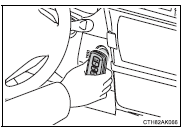Toyota Corolla (E170): Starting the engine
1 Continuously variable transmission: Ensure that the shift lever is in P and depress the brake pedal.
Manual transmission: Shift the shift lever to N and depress the clutch pedal.
2 Touch the Toyota emblem side of the electronic key to the engine switch.
When the electronic key is detected, a buzzer sounds and the engine switch will turn to IGNITION ON mode.
When the smart key system is deactivated in customization setting, the engine switch will turn to ACCESSORY mode.

3 Vehicles without a multi-information display: Firmly depress the brake pedal (continuously variable transmission) or clutch pedal (manual transmission) and check that the smart key system indicator light (green) turns on.
Vehicles with a multi-information display: Firmly depress the brake pedal (continuously
variable transmission) or clutch pedal (manual transmission) and check that
 is shown on the multi-information display.
is shown on the multi-information display.
4 Press the engine switch.
In the event that the engine still cannot be started, contact your Toyota dealer.
■Stopping the engine
Shift the shift lever to P (continuously variable transmission) or N (manual transmission) and press the engine switch as you normally do when stopping the engine.
■Replacing the key battery
As the above procedure is a temporary measure, it is recommended that the electronic key battery be replaced immediately when the battery is depleted.
■Changing engine switch modes
Release the brake pedal (continuously variable transmission) or clutch pedal (manual transmission) and press the engine switch in step 3 above.
The engine does not start and modes will be changed each time the switch is pressed. ■When the electronic key does not work properly
●Make sure that the smart key system has not been deactivated in the customization setting. If it is off, turn the function on.
●Check if battery-saving mode is set. If it is set, cancel the function.
Other materials:
How to scroll
: Select to scroll to the next or
previous page.
: If
appears to the right of titles, the
complete titles are too long for the display. Select this button to scroll the title.
Turn the “TUNE/SCROLL” knob to move the cursor box to select a desired item from
the list, and press the â ...
Cruise control
Preparation
Sst
Recomended tools
Equipment
...
Circuit description
The crankshaft position sensor (ne signal) consists of a magnet, iron core
and pickup coil.
The ne signal plate (crankshaft position sensor plate) has 34 teeth and is
installed on the crankshaft. The
ne signal sensor generates 34 signals for each engine revolution. This sensor
monitors a p ...


